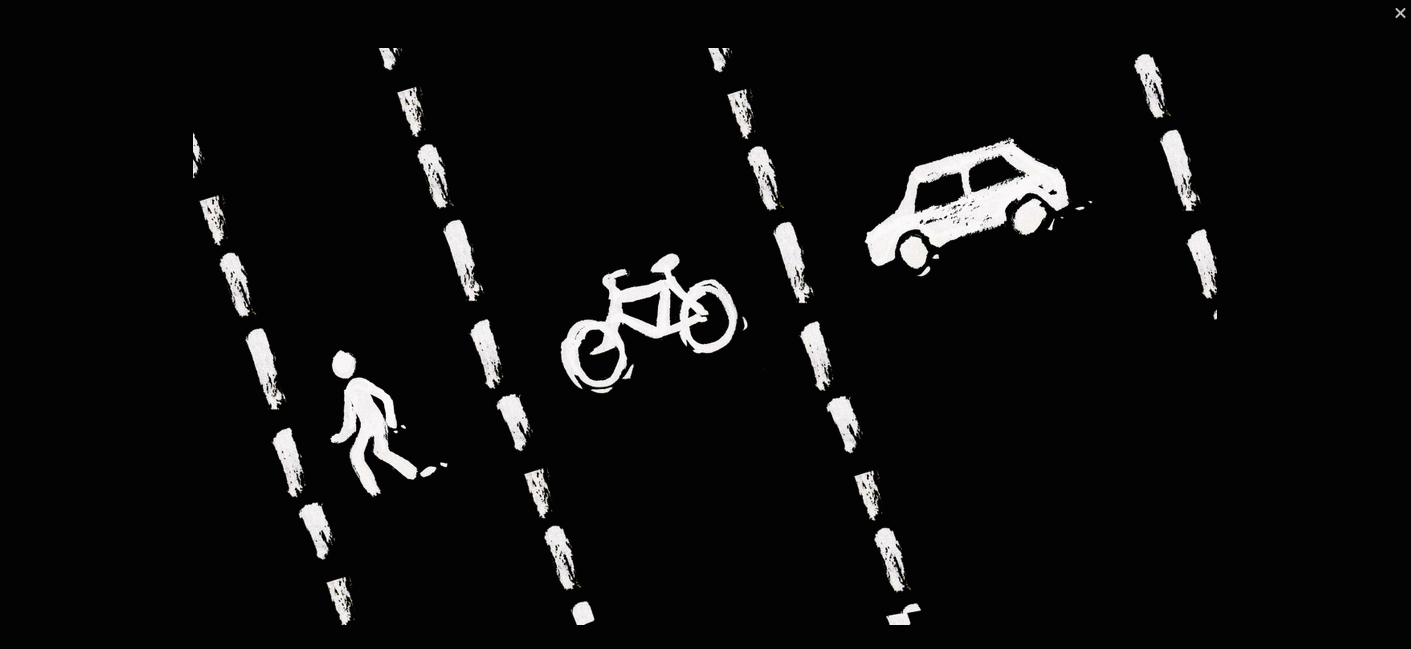 On the morning of Sunday, May 1, 2011, residents of the Audubon district awoke to find a bold new crosswalk at the intersection of Whitney Avenue and Audubon Street. Spray-painted and slightly crooked, the rogue act made headlines around town. Opinions differed—officials said the sight lines weren’t clear enough for a crosswalk, business owners liked that it made it easier for people to get to their stores, and some just thought it looked a little funny. Useful or not, the crosswalk was illegal and officials had the paint removed two days later. The impromptu markings made a point, however: the intersection was dangerous. The city needed to rethink its streets.
On the morning of Sunday, May 1, 2011, residents of the Audubon district awoke to find a bold new crosswalk at the intersection of Whitney Avenue and Audubon Street. Spray-painted and slightly crooked, the rogue act made headlines around town. Opinions differed—officials said the sight lines weren’t clear enough for a crosswalk, business owners liked that it made it easier for people to get to their stores, and some just thought it looked a little funny. Useful or not, the crosswalk was illegal and officials had the paint removed two days later. The impromptu markings made a point, however: the intersection was dangerous. The city needed to rethink its streets.
Following the deaths of two young pedestrians in New Haven in the spring of 2008, residents, elected officials, and local organizations established the Safe Streets Coalition. The group was formed to advocate for streets that are “livable, walkable, bikeable, economically viable, environmentally sound, and safe for residents of all ages and abilities,” according to its website. The coalition launched the Connecticut Livable Streets Campaign, which began to lobby for local and statewide “complete streets” legislation. By July 2009, the legislation, which encourages engineers to implement “traffic calming measures” and make “walkability” a priority, had passed in both New Haven and the state capital. That year, an education campaign called “Street Smarts” launched, informing Connecticut residents about the safe use of streets. It included advice on how to be visible to drivers at night and cautioned against dangerous behavior like jaywalking. A year later, a small group of New Haven engineers created a design manual to help other cities comply with “complete streets” policies. (The state has committed to finishing its own manual by 2017.) Still, according to the 2012 DataHaven Community Wellbeing Survey, forty-one percent of New Haven residents say that their neighborhood is unsafe for bicycling, and nineteen percent say that there are no safe sidewalks or crosswalks.
In response to these safety concerns, a new kind of urban planning—the “complete streets” movement—is underway in New Haven and across the country. The idea behind complete streets is simple: roads should be built for their users. All of their users, not just drivers. It’s particularly important in a compact urban community like New Haven. Mark Abraham, executive director of DataHaven, reports that nearly thirteen percent of workers, around 7,500 residents, say they walk to work every day. Roughly three percent, or 1,500 workers, make their daily commute by bicycle. Yet most streets are only designed with the needs of drivers in mind, because, despite the new 2009 legislation, state laws generally require that roads maximize the efficiency of auto traffic. Until recently, the Connecticut Department of Transportation was called the Connecticut Department of Highways, and many advocates still find that it overemphasizes the role of automobiles in transportation.
“You should be designing for the street you want. That’s not how most engineering is done,” said Doug Hausladen, New Haven’s current director of transportation, traffic, and parking. When Hausladen was appointed to the position in 2013, he realized that the number of complete streets project proposals submitted far outpaced his office’s ability to carry them out. The proposals, which detail community members’ concerns and their proposed solutions, reflect the desire for improved streets throughout New Haven. But Hausladen could only implement about one project per year, given budget and time constraints. One of the first of these projects was a new crosswalk across Whitney at the site of the rogue crosswalk. Now, the site is decked out with pedestrian-activated LED lights that flash to alert drivers when a pedestrian is crossing. Curb extensions at the crosswalk shorten the width of the street by sixteen feet to make crossing easier for pedestrians, and a speed table—like an extended speed bump—forces drivers to slow down as they approach the crosswalk. Because of the intersection’s layout, the project was complex and costly. It took nearly a year, and required a $150,000 subsidy from Yale. Its total cost was approximately $320,000.
But the city doesn’t have enough money to spend over a quarter-million dollars per intersection. Now, three years after the spray paint was scrubbed from Whitney Avenue, Hausladen and City Engineer Giovanni Zinn have a more cost-effective plan for rethinking the streets of New Haven. It’s called “Complete Streets 2.0,” and it aims to find solutions that are inexpensive and easy to implement—solutions that actually look a lot more like the spray-painted crosswalk than the high-tech system of strobe lights and other modifications that exists there today.
“This is Mayor Harp and all the complete streets activists finally realizing the promise that we made in the 2009 legislation,” Hausladen said. The first Complete Streets 2.0 project—a re-design of Edgewood Avenue—was announced in November. It is set to reach completion in May 2015 at a cost of only $80,000. The design reengineers a 2.1-mile stretch of Edgewood to accommodate not only automobile traffic, but also bicyclists and pedestrians. “We are not afraid to rethink the entire space of the roadway,” Hausladen said. “Every inch of the roadway is valuable, and we can find a way to use it effectively and safely.”
By using inexpensive materials like paint, delineator tubes, and traffic bollards, Complete Streets 2.0 aims to increase the number of completed projects to at least ten per year, giving community members the results they want more quickly. “Granite curb costs me forty dollars a foot to install,” explained City Engineer Giovanni Zinn. “A six-inch white line only costs me forty cents a foot. I can replace that line many, many times before it even gets close to costing what a curb would, and we can keep tweaking it until we find the best solution,” he added. Complete Streets 2.0 is unique in its ability to implement projects quickly and allow them to “fail fast” if they are ineffective. “It leaves room for mistakes, because none of us have all of the answers,” said Liam Brennan, a community activist and a member of Elm City Cycling, a local advocacy group.
But the proposed changes can seem dubious to those unfamiliar with the complete streets philosophy. “People understand the low-dollar stuff, but they are still a little nervous about me removing a travel lane,” Hausladen said, referring to the plans for Edgewood Avenue, which will convert a traffic lane into a bike lane. “Some of the logic can be counterintuitive,” Brenan said. “People might think that wider streets means safer streets because no one has explained the studies that show that a narrower street causes cars to drive slower, which ends up being a safer environment overall.” And by making it easier for people to walk and bicycle, complete streets provide alternatives to driving a car, therefore reducing pollution.
Educating the community about complete streets is an ongoing challenge for Hausladen and his team. Hausladen has a far-reaching idea of what these streets can do. According to him, complete streets are the right move, not merely because they make cities safer and reduce their environmental impact, but because complete streets help create a city that is simply a better place to live—a vibrant city filled with ideas, activities, and thriving businesses. “Community needs more humans interacting day to day. Good ideas come from conversations,” Hausladen said, explaining that people do not have those opportunities for interaction in a “carbon community” where everyone is commuting in individual cars, cut off from one another.
Advances in car technology make it increasingly easy to travel by vehicle, but the ease comes at a price of busier streets and more disconnected city life. It turns out the amateur urban planners on Whitney Avenue were onto something: sometimes the solution to congested streets and dangerous crosswalks can be as simple as some white paint. Local voices are calling out for better design, but the state’s policies lag behind. Still, Hausladen finds the recent improvements to New Haven’s streets encouraging.
“No matter how much amazing transportation we have in the future,” he said, “people are still going to want to have a more pleasant experience crossing the street.”


